
SI Joint Fusion
Once your spine doctor has confirmed the source of your symptoms is Sacroiliac joint pain and you have attempted conservative treatment options such as physical therapy, SI joint injections and pain medication it may be time to consider surgical treatment. One option is Sacroiliac (SI) joint fusion.
SI joint fusion is a minimally invasive surgical procedure requiring a small incision (about one to two inches long), along the side of the buttock. Your spine surgeon will use fluoroscopy or navigation, a real-time imaging technique, to precisely place titanium implants across the SI joint for better stability.
Traditional "Open" SI Joint Fusions Surgery vs. iFuse Minimally Invasive SI Joint Fusion
Traditional or "open" SI joint fusion surgery is very different than the iFuse minimally invasive option. Open SI joint surgery requires a significant amount of soft tissue dissection to get to the joint and a significant amount of joint debridement -- the removal of damaged tissue — to prepare the joint for fusion. This leads to longer recovery time, which may include several days at the hospital. Open surgery also carries a greater risk of post-operative complications than minimally invasive surgery.
iFuse Implant System
The iFuse Implant System is intended for sacroiliac joint fusion for conditions including sacroiliac joint dysfunction that is a direct result of a sacroiliac joint disruption or degenerative sacroiliitis. The procedure involves the insertion of three small, triangular, titanium implants across the SI joint. The procedure is done through a small incision and takes approximately one hour. Clinical studies have demonstrated that treatment with the iFuse Implant improved pain, patient function and quality of life.*
Benefits of the iFuse Implant System:
- Titanium construction designed specifically to stabilize and fuse the SI joint
- Triangular shape minimizes rotation
- Porous titanium surface allows for bony ongrowth/ingrowth
* Polly, D.W., Two-Year Outcomes from Randomized Controlled Trial of Minimally Invasive Sacroiliac Joint Fusion vs. Non-Surgical Management of Sacroiliac Joint Dysfunction. Int J Spine Surg. 2016; 10:Article 28.
REFERENCE: "Randomized Trial of Sacroiliac Joint Arthrodesis Compared with Conservative Management for Chronic Low Back Pain Attributed to the Sacroiliac Jointprestigious Journal of Bone and Joint Surgery," published in the prestigious Journal of Bone and Joint Surgery.

Where we provide SI Joint Fusion Services
-
 Hoag Orthopedic Institute Hospitals & Surgery Centers 16250 Sand Canyon Ave.
Hoag Orthopedic Institute Hospitals & Surgery Centers 16250 Sand Canyon Ave.
Irvine, CA 92618View Location -
 Hoag Orthopedic Institute Surgery Center - Newport Beach Hospitals & Surgery Centers 22 Corporate Plaza, Suite 150
Hoag Orthopedic Institute Surgery Center - Newport Beach Hospitals & Surgery Centers 22 Corporate Plaza, Suite 150
Newport Beach, CA 92660View Location -
 Newport Orthopedic Institute - Huntington Beach Orthopedics Physician Offices 19582 Beach Boulevard, Suite 306
Newport Orthopedic Institute - Huntington Beach Orthopedics Physician Offices 19582 Beach Boulevard, Suite 306
Huntington Beach, CA 92648View Location -
 Newport Orthopedic Institute - Irvine Orthopedics Physician Offices 16300 Sand Canyon Ave, Suite 400
Newport Orthopedic Institute - Irvine Orthopedics Physician Offices 16300 Sand Canyon Ave, Suite 400
Irvine, CA 92618View Location -
 Newport Orthopedic Institute - Newport Beach Orthopedics Physician Offices 22 Corporate Plaza Drive
Newport Orthopedic Institute - Newport Beach Orthopedics Physician Offices 22 Corporate Plaza Drive
Newport Beach, CA 92660View Location
Stories about our SI Joint Fusion Services
-
- Spine
Cervical Discectomy
Provider: Michael L Gordon MD“Dr. Gordon provides first class care!” -
- Spine
Spinal Interventional Procedure
Provider: Balaji (Bobby) S Charlu MD“Dr. Charlu is a great doctor and always explains everything to you. He is very caring.” -
- Spine
Spinal Interventional Procedure
Provider: Balaji (Bobby) S Charlu MD“Dr. Charlu helps me manage pain without taking pain medicine.” -
- Spine
Total Hip Replacement
Provider: Ram Mudiyam MD“Nice office, nice people, good Doctor and immediate support staff. I can tell Dr. Mudiyam treats his employees well and that everyone there loves what they do.” -
- Pain Management
Spinal Injections Epidural/Facet
Provider: Balaji (Bobby) S Charlu MD“Amazing and very professional. Explained everything that was happening as well as made me feel comfortable.” -
- Spine
Lumbar Discectomy
Provider: Richard S Lee MD“I believe that everything was very well organised, looking forward to seeing Dr Lee again for the next steps.”
Related Videos
-
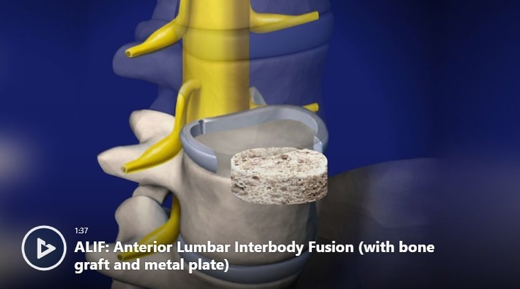 ALIF: Anterior Lumbar Interbody Fusion (with bone graft and metal plate)Watch Video
ALIF: Anterior Lumbar Interbody Fusion (with bone graft and metal plate)Watch Video -
 ALIF: Anterior Lumbar Interbody Fusion (with bone graft and pedicle screws)Watch Video
ALIF: Anterior Lumbar Interbody Fusion (with bone graft and pedicle screws)Watch Video -
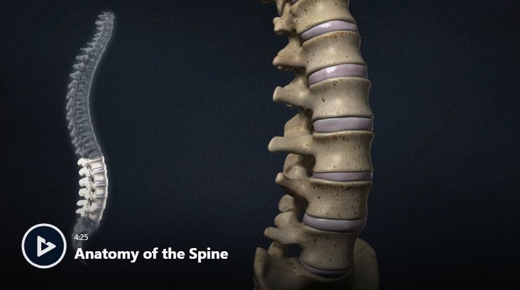 Anatomy of the SpineWatch Video
Anatomy of the SpineWatch Video -
 Anterior Cervical Corpectomy (Bone Graft)Watch Video
Anterior Cervical Corpectomy (Bone Graft)Watch Video -
 Anterior Cervical Discectomy and Fusion (ACDF)Watch Video
Anterior Cervical Discectomy and Fusion (ACDF)Watch Video -
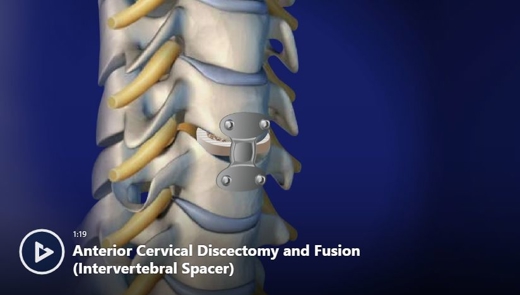 Anterior Cervical Discectomy and Fusion (Intervertebral Spacer)Watch Video
Anterior Cervical Discectomy and Fusion (Intervertebral Spacer)Watch Video -
 Artificial Cervical Disc ReplacementWatch Video
Artificial Cervical Disc ReplacementWatch Video -
 Artificial Cervical Disc Replacement (Mobi-C®)Watch Video
Artificial Cervical Disc Replacement (Mobi-C®)Watch Video -
 Artificial Cervical Disc Replacement (PCM)Watch Video
Artificial Cervical Disc Replacement (PCM)Watch Video -
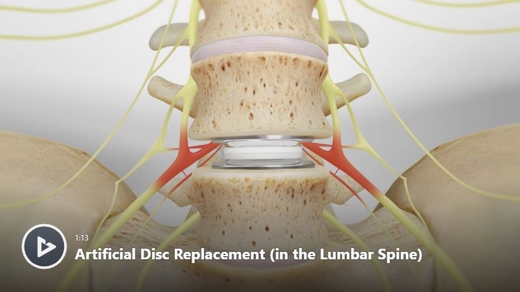 Artificial Disc Replacement (in the Lumbar Spine)Watch Video
Artificial Disc Replacement (in the Lumbar Spine)Watch Video
Blogs about SI Joint Fusion
-
 Lower Back Pain And Weight Training: How To Hit The Gym Without Hurting Yourself
Lower Back Pain And Weight Training: How To Hit The Gym Without Hurting YourselfOkay, I know you: the gym is where you live between work and your bed. You pride yourself on ripped abs, thrashed glutes, and cut quads. You could ...
Read More -
 Dr. Gordon Speaks on Neck Arthritis
Dr. Gordon Speaks on Neck ArthritisDr. Michael Gordon was recently interviewed by U.S. News & World Report regarding common symptoms experienced by patients with neck arthritis, ...
Read More -
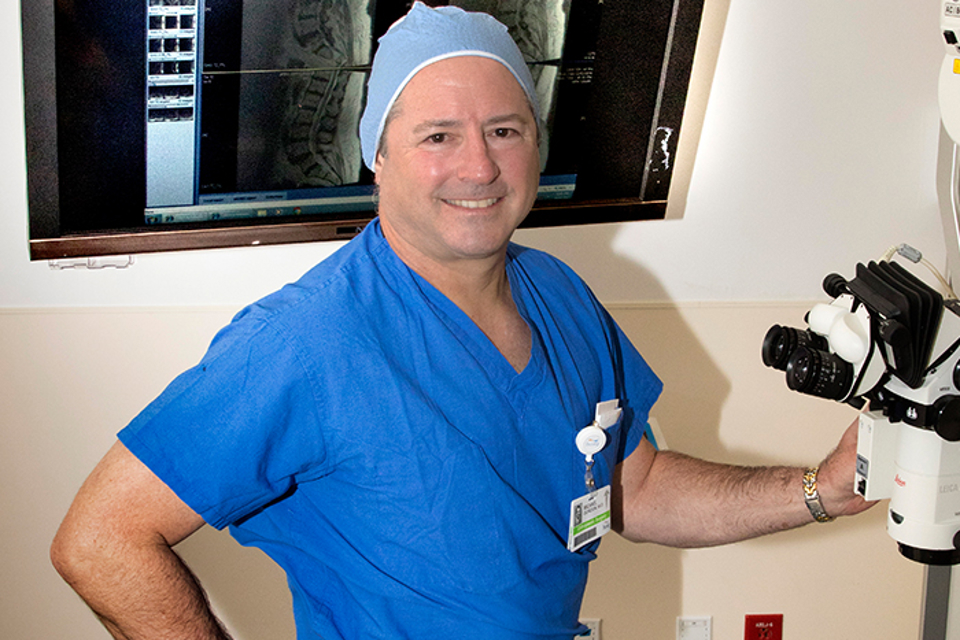 Returning to Sports After Minimally Invasive Spine Surgery
Returning to Sports After Minimally Invasive Spine SurgeryPatients planning for their minimally invasive spine surgeries have many concerns, not the least of which include the nature of their surgery, the ...
Read More -
 The Weight of Knowledge - Schoolbooks and Your Kid's Back
The Weight of Knowledge - Schoolbooks and Your Kid's BackThis is the time of year where mothers and fathers across the land begin to worry about what gear their students need for school, and questions about ...
Read More -
 PA Spotlight: James Marchetti
PA Spotlight: James MarchettiJames Marchetti is a Physician Assistant for Dr. Michael Gordon and specializes in caring for patients suffering from acute and chronic low back pain ...
Read More -
 Understanding Sacroiliac (SI) Joint Pain & Stretches to Help You
Understanding Sacroiliac (SI) Joint Pain & Stretches to Help YouEach of us has two SI or sacroiliac joints in our lower back. On a good day, they are responsible for carrying our upper body and keeping us balanced ...
Read More





